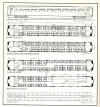When they
finally entered service we still had to ride shotgun for a few months as
there were a few teething troubles to be overcome.
The author well remembers
spending the period of the 1990 World Cup on nights at Neville Hill depot in
Leeds assisting in fault-finding and maintenance of the Mk 4 coaches - and
watching the matches on the Metro Cammell cabin's television.
One problem
related to the
coaches' air conditioning systems which were subject to extreme failure conditions
which either froze or fried the passengers. The problem was exacerbated by
the fact that the controls were not accessible from within the coach. This problem was to dog the
Mk4
coaches for many years until after privatisation when Angel Trains (the Rosco)
finally put some money up and sorted the problem. Ironically we were asked
to monitor the performance of the coaches again - ten years on.
This problem
became a standing joke and the phrase 'There's always a warm welcome on
GNER' was often quoted.
Other
problems related to the toilets which suffered from 'blow back' when the
train entered a tunnel - no need to go into detail here. The toilet door
locks were also a problem since the sliding doors were unable to cope with a
determined effort to open them - locked or not. Many an unfortunate
passenger was caught on the loo before the problem was overcome.
The coaches
were fitted with the Swiss SIG type BT41 bogies and the rode like pigs at
125 mile/h although the bogies had a good reputation on the Continent. For
some reason they were not happy on BR track and we had to put up with irate
passengers who likened the Mk4's to the Blue Pullman - which had abysmal
ride qualities.
The
overriding memory of the early service days was rattling round curves like
Hatfield with frequent lateral bump stop contact which was described as 'threepenny
bit curving'. Eventually after extensive testing and major modifications the
SIG bogies achieved an acceptable ride quality on BR tracks.
These mods
included changing the bogies' vertical and lateral dampers, alterations to
the spring rates of the bogies and the fitting of inter-vehicle dampers.
Most unusual of all was the reversing of the bogies (yes turning the bogie
through 180 degrees) to reduce the pitch input from the bogie to the coach
body) - now if they'd only opted for the T4 BREL bogie ... who knows?










